The Republican F-84 Thunderjet / Thunderstrike / Thunderflash. Part II. Swept wing
Although the XF-84F flight data at low altitudes were good, the United States Air Force required the installation of a more powerful engine in order to improve the aircraft’s landing and landing characteristics, the climb rate and the speed data at higher altitudes. For this, an English turbojet engine was selected with an axial compressor Armstrong-Siddley "Sepfire" 3269 kg. It was decided to purchase a license to manufacture an engine in the United States at Curtiss Wright under the designation J65.
The engine "Sepfire" was more than J35, which forced to make major improvements to the XF-84F fuselage. The height of the fuselage increased by 13 cm, the air intake became a larger, elliptical section. The first experienced HF-84F was reequipped for the "Sepfire" purchased in England. The first flight with the new engine took place on February 14 1951 of the year.
In 1951, Ripablik released two pre-series YF-84F under the English engine. The second plane was equipped with side air intakes in the wing root, and the nose was equipped with a blind cone. Wing air intakes led to a loss of thrust compared to a frontal air intake and were not used on this aircraft in the future.
According to the initial plans of August 1950, Thunderstrike should be launched into the series in the autumn of the same year. The production of the F-84F required large extruded parts used in the swept-wing design. However, the only powerful press in the US was loaded with work on the B-47 bomber production program. The breakdown of this press led to a further delay in work. Moreover, there were serious problems with the development of the licensed production of the engine "Sepfire". In July, 1951, Ripablik was forced to warn the US Air Force about the impossibility of observing the schedule for deploying the production of a new model.
To give a new impetus to the F-84F program, it was decided to make changes to the design of the aircraft wing, making it possible to produce it using the existing machine park. Although this removed the problem of the lack of a powerful press, other problems arose. As a result, the United States Air Force ordered to continue production of the F-84G straight-wing model, in order to fill a pause in anticipation of the start of F-84F shipments.
The first serial F-84F was first prepared to take to the air only at the end of the autumn 1952 of the year. The serial fighter differed from the planes of the installation batch with a new lantern. On prototype cars, the cockpit canopy was the same as on straight-wing aircraft models. On serial machines, the movable section of the flashlight now received a rocker lever, on which he first went up and then moved back. To open the lantern, it was enough for the pilot to push it upwards, and in an emergency, the movable lantern section could be dropped. The new lantern was more durable, it was easier to mount on the plane and had a more reliable sealing compared to the previous lantern that was sliding back.
The serial F-84F also received a gargrot hump behind a cockpit lantern. The YF-84F had one air brake under the fuselage of the aircraft, like the Thunderjacks. On the serial "Thunderstrik" it was replaced by two perforated panels on the sides of the rear fuselage behind the rear edge of the wing. New air brakes could be used even at maximum dive speeds without the appearance of buffering or a major change in controllability.
To improve the bearing characteristics of the wing slats were installed. Trimmers were removed from the ailerons, and irreversible boosters were used instead. In the production of "Thunderstrike" in Farmingdale participated as contractors "Kaiser metal product" from Evasville, Indiana, which built the fuselages, "Servell" from Evansvipla, Indiana, which produced the wings, and "Goodyear Aircraft", which produced the lamp and outfit and garnets, Garry, Ind. .
In 1952, the second Thunderstrike manufacturer appeared - General Motors plant in Kansas City received an order for mass production. This plant during the years of World War II was used by the North American to manufacture the B-25 Mitchell bomber. At the end of the 1953 of the year, the first F-84F was released with a full turning stabilizer. The first "Thunderstriks" tended to lowering during heavy overload maneuvers, which sometimes ended simply with the loss of wings. It is worth noting that other American fighters suffered from a similar problem in those years. American standards of strength were lower than the Soviet ones, which made it possible to lighten the design of the aircraft, but often at an excessively expensive price. The all-round stabilizer mitigated this problem, but during the entire period of operation of the F-84F, there were restrictions on a number of maneuvers, which naturally reduced the combat value of the vehicle as a fighter.
In March, the F-1955F was released with a more powerful J84-W65 engine 7 kg. Although restrictions on the velocity head due to the weakness of the design did not allow for raising the flight speed, the aircraft climb rate and its combat ceiling increased.
The latest production versions, produced in Fermingdale, outwardly differed a small fairing under the fuselage that accommodated the braking parachute, which was later received by the previously released aircraft series. The last Thunderstrike came off the assembly line at the Fermingdale plant in August 1957. In total, they were released 2112 machines of this model. Another 599 released General Motors. By June 1955, the United States Air Force had twelve wings with F-84F. Six of them were part of the Tactical Air Command and six as part of the Strategic Air Command.

F-84F served in Tactical Command as carriers of nuclear weapons. At the same time they were equipped with a system of bombing from low altitudes. The tactics of using nuclear weapons from Thunderstrik included a breakthrough to the target at maximum speed and at low altitude, cabreling, dropping a bomb and avoiding the damaging factors of a nuclear explosion back on the same route.
The “Tanderstriks” in the US Air Force Strategic Command were used as escort fighters for the B-29, B-50 and B-36 bombers. As these bombers were replaced with reactive F-84Fs, they were transferred to the Tactical Command. By the middle of 1957, all Thunderstrike were put in there.
Pilots Thunderstrike "noted that the plane is quite difficult to manage. With take-off weight up to 9080 kg and landing speed above 250 km / h, the plane required pilots who were used to lighter fighters to get quite tense and neat aerobatics. Generally, the F-84F controllability was unimportant, some maneuvers were banned, except in extreme cases.
Gradually, "Thunderstrik" were replaced by the North American F-100 "Super Seybr." Most of the F-84F was surrendered to the Air Force National Guard. However, the Berlin crisis 1961 years has led to the return to operation of many of these fighters - Europe urgently transferred from the National Guard 141-Squadron Tactical Fighter Air Base McGuire, 163-Squadron from Fort Veyen, Indiana, and 166-Squadron with Columbus, Ohio airbase. The F-84F remained part of the Tactical Command until the mid-sixties, when they were replaced by McDonnell F-4 "Phantom" fighters. From the National Guard Air Force, the F-84F were withdrawn at the end of the 60-x, and the last F-84F ended service in the 1971 year.
A large number of F-84F was supplied to the air forces of other NATO countries. Of the 2711 Thunderstrikes, 1301 was delivered to Europe by the US allies. The first "Thunderstrik" France received in 1955 year. They armed 1, 3, 4, 6 and 11 squadrons. It was in the composition of the French Air Force that the Thunderstrike managed to “smell the powder” while participating in the Suez crisis of the 1956 of the year. October 23 The French Thunderstrikes from the 36 Squadron flew to Israel, but the Liddia base and the 1 Squadron fighters flew to Cyprus. The French Thunderstrike with Liddia, starting from 3 October, supported the offensive of the Israeli forces in the Sinai Peninsula. Airplanes from Cyprus launched raids on Egyptian airfields from November 29. The Thunderstrike, based in Israel, managed to destroy on the ground 1 Egyptian IL-12 bombers, and one shot down in the air. Fights continued until November 28. In this case, one F-6F was shot down. French F-84F in the mid-sixties were replaced by "Mirage."
The Belgian Air Force began to receive F-84F since August 1955. They replaced the F-84 "Thunderjacks" in the 2-th and 10-th fighter-bomber wings. Most of the Belgian F-84F in the early sixties were replaced with F-104 "Starfighters". In the Dutch Air Force on the 1956 year there were six fighter-bomber squadrons with F-84F. At the beginning of the 60s, they were also changed to F-104C Starfighters. The Italian Air Force had three air brigades with the F-1956F in 84.
The newly created German Luftwaffe received quite a lot of F-84F. "Thunderstrik" were actually the first combat aircraft of the new Luftwaffe after the Second World War. 20 June 1958, the first German fighter-bomber wing - Jabo G.31 entered service. Soon he was also joined by Jabo G.32, G.34 and G.35. In total, the Luftwaffe from the end of the 50-x to the beginning of the 60-x was used to 450 "Thunderstrik." Then they were gradually replaced by F-104 "Starfighters".
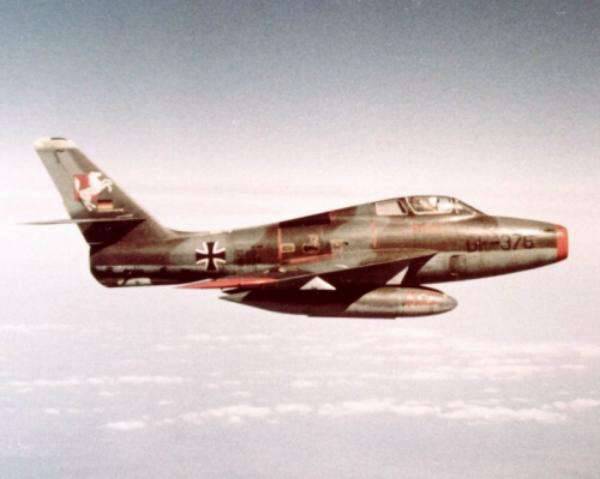
Part of the former German, Belgian and Dutch Thunderstriks was later transferred to Greece and Turkey. It was quite characteristic: once a new combat aircraft had got to Greece, it was immediately delivered to another “ally” - Turkey. Some Thunderstrike remained in service until the end of the seventies, when they were replaced by the Northrop F-5. F-84F was used by the Turks during the Cyprus crisis in the middle of the 70-s, but, apparently, the Greek and Turkish Thunderstriks did not meet in battle.
The RF-84F was a photo-scanner based on the Thunderstrike F-84F. In general, it was similar to the F-84F, but the engine air intakes were located in the root of the wing, freeing the nose for a whole battery of cameras. As already mentioned, the second experienced YF-84F was made with side air intakes at the root of the wing and with a nose cone. At that time, it was concluded that the side air intakes lead to a loss of engine thrust, and therefore were not used on the Tanderstrik serial F-84F. However, since the United States Air Force needed to replace the outdated Lockheed RF-80 scout "Shooting Star", it was decided to use the YF-84F as a prototype for the photo scout. The first pre-production reconnaissance aircraft YRF-84F was completed in February 1952. The aircraft had side air intakes and photographic equipment in the new, elongated nose of the fuselage. Armament consisted of four 12,7-mm machine guns. Lantern cockpit has been strengthened. Later, aerodynamic ridges appeared on the wings.
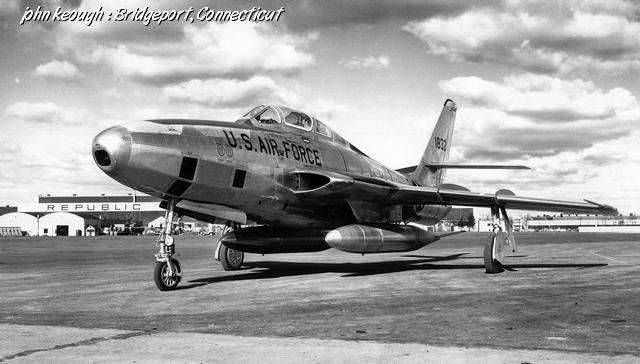
In June, 1952 G followed up with an order for 41 scout RF-84F. For the aircraft, the designation "Thunderflash" was chosen. Instead of a sliding flashlight, the first serial scout received a reinforced, rising-up flashlight from the F-84F. The first series of cars was equipped with Wright J65-W3 engines. In June, the 1955 G series was launched with the Wright J65-W7 engine 3541 kg. The last series of RF-84F received spoilers on the upper surface of the wing, which made it possible to raise the angular velocity of the roll to 300 degrees / sec. This was done primarily to enable the asymmetric suspension of the underwing fuel tanks. The photographic equipment compartment in the nose contained six cameras - forward, down, to the sides and at an angle. The cameras aimed down were closed with flaps hydraulically retracted in flight. Behind the doors of the cameras was the lens of the periscope video finder mounted in the cockpit. In the wing tanks it was possible to install an automatic launch of lighting flares for shooting at night.
Deliveries of RF-84F Thunderfleshov began in March 1954 of the year. First, they entered the 363 wing of tactical intelligence at the Shaw air base in North Carolina. In June 1956, in service with the US Air Force, there were four wings with RF-84F. In January, the 1958 plant in Fermingdale passed the last 715 RF-84F. At one time or another, these aircraft consisted of 17, 25, 32, 38, and 155 photo reconnaissance squadrons, 13, 15, 82, and 1561 tactical reconnaissance squadrons and 20 th and 91 th reconnaissance squadrons.
The RF-84F service career as a part of the USAF was short - by the end of the 50-x - at the beginning of the 60-x they were replaced by McDonnell RF-101 Voodoo. But during the sixties, RF-84F served as part of seven squadrons of the National Guard. Of these 715 scouts, 386 vehicles were transferred as part of the military assistance program to NATO allies. The RF-84F scouts were in service with the West German Luftwaffe (Aufkl. G51 and G52), the French Air Force (in the 33 Squadron), the Belgian Air Force (42-I Squadron), the Holland Air Force (306-Squadron Squadron), and the Netherlands Air Force (18-I Squadron), the Dutch Air Force (132-Squadron). I and 729-I group), Danish Air Force (717-I Squadron), Norwegian Air Force (XNUMX-I Squadron), Turkish and Greek Air Forces.
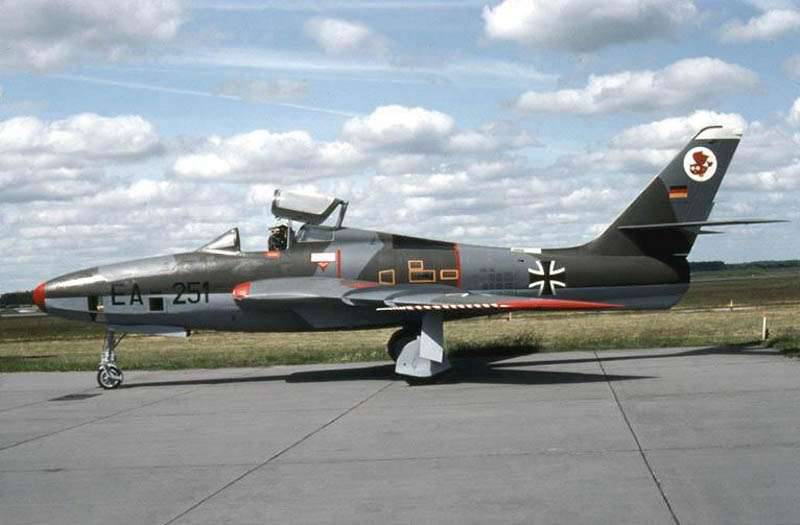
F-84F somewhat lost in the climb rate compared with previous versions, and its maximum speed significantly decreased with the altitude. To raise the flight characteristics of the aircraft, the United States Air Force suggested that Republic should develop a version of "Thunderstrike" under the new engine General Electric J73. The project received the designation F-84J.
As a first step, it was decided to install the General Electric XJ84-GE-73 engines 5 kg and XJ3972-GE-73 7 kg on two F-4050F series serials. The engines had a large diameter, which forced the F-84F fuselages to be redone. These two aircraft received the designation YF-84J.
The first YF-84J was circled around 7 in May of 1954. The more powerful J73 engine allowed the YF-84J to show speeds up to M = 1,09. However, the order for it from the US Air Force did not follow, as the necessary changes in the work of the assembly lines were considered too expensive. In addition, the F-100 Super Saber fighter was launched into service with the flight speed M = 1,25, which more fully met the requirements of the US Air Force for the new fighter. As a result, all work on the second YF-84J in June 1954 g was stopped, and the entire program was curtailed 31 August 1954 of the year.
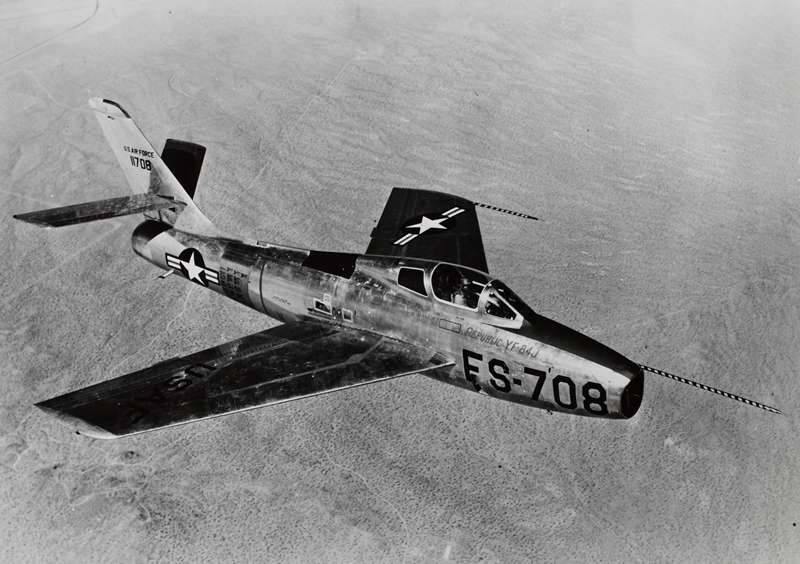
XF-84H was a project of a promising, turboprop combat aircraft. Although usually this aircraft was considered only as a test machine for high-speed propellers, the US Navy seriously considered the possibility of using the XF-84H as a deck attack aircraft. The aircraft's armament consisted of one 15,25-mm T-45 machine gun with 1200 ammunition and ammunition loads weighing up to 1800 kg.
Despite its designation, the XF-84H was in fact a new aircraft that had little in common with the serial F-84F and RF-84F. The XF-84H was so different from them that, according to some sources, it originally wore the designation F-106 - that is, it was in fact one of the “hundredth series” aircraft. However, there is no weighty evidence of this.
In May 1952 of the year, an inspection inspection of the HF-84H project took place, and two prototype aircraft were ordered on 15 in December of the same year. Although the XF-84H kept the wing and cockpit from the F-84F, the aircraft was otherwise different from its predecessors. The power plant was a Allison XT-40-A-1 turboprop engine with 5850 horsepower. with a three-bladed propeller "AirProducts", which had supersonic blades. In addition to the screw, the engine also provided 588 kg of thrust from the exhaust. Since the propeller was mounted in the nose of the fuselage, the engine air intakes were placed in the wing root. Due to this, the aircraft was similar to the RF-84F, although the air intakes on the latter were significantly larger. The XF-84H fuselage was longer than that of the F-84F, and under the cockpit there was a triangular ventral crest compensating for the large jet torque.
The aircraft also had a T-shaped plumage with a very high keel. XF-84H made its first flight 22 July 1955 g. Flight data were too low to not pay attention. The XF-84H speed was not higher than 832 km / h - much lower than the calculated 1072 km / h. So that the plane could in no case be considered supersonic. Technical problems with the car were generally a nightmare. Of the eight flights carried out on an experimental plane, only one did not end with a forced landing. To crown it all, the propeller and turbine of the aircraft made howls on the ground, like an air-raid siren, so that ground personnel perceived it as a real signal to take cover.
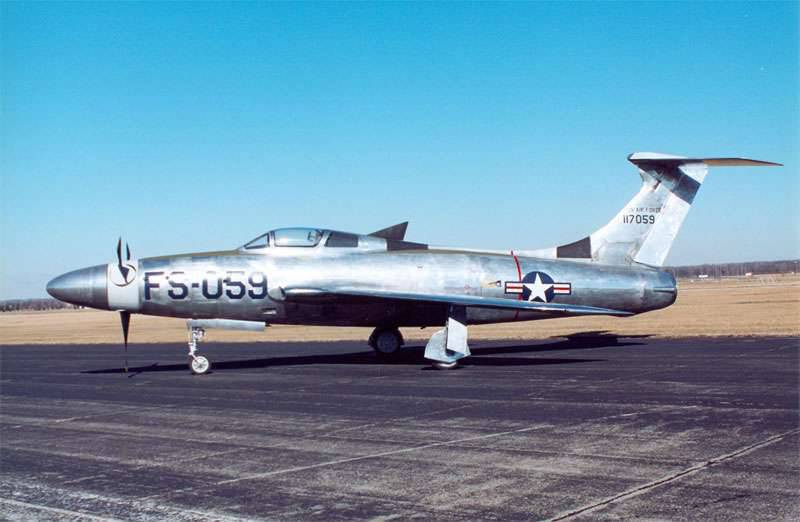
Initially, the U.S. fleet showed serious interest in the aircraft as a possible carrier-based attack aircraft, but the development of steam catapults, the use of a corner deck and air refueling made it possible to abandon the need to maintain a deck combat aviation screw propulsion. The fleet quickly lost interest in the aircraft, especially after identifying numerous technical problems. All work on the XF-84H was soon discontinued.
The fate of the second prototype in different sources is described differently. Some say that he never flew, while others said that four flights were completed before the work was completed. It was stated that the XF-84H number 51-17060 was exposed during the "open door" at the airport in Bakersfield, California. But where he is now is not known.
Sources:
Chechin A., Okolelov N. F-84. "Jet Thunder" over Korea // Wings of the Motherland. 1997 .№2. C. 13-19.
Green W., Cross R. Jet aircraft of the world. M .: Publishing house of foreign literature, 1957. C.142-143, 177-178.
Chechin A., Okolelov N. Reactive in Korea // Model Designer. Special edition. 2005. No.1. C. 17-32.
Firsov A. US Fighters // Aviation Collection. No.14. C. 48-52.
A. Chechin, N. Okolelov. F-84 Starfire Fighter // All Korean War Jets. M .: Yauza, 2014. C. 32-45.
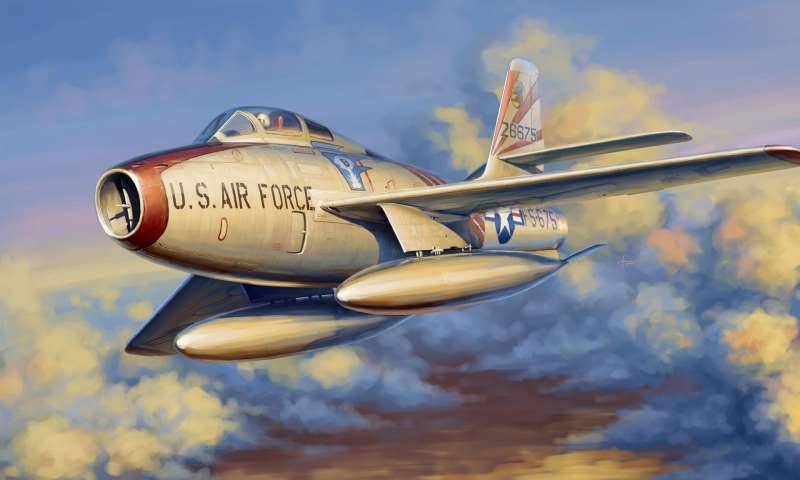
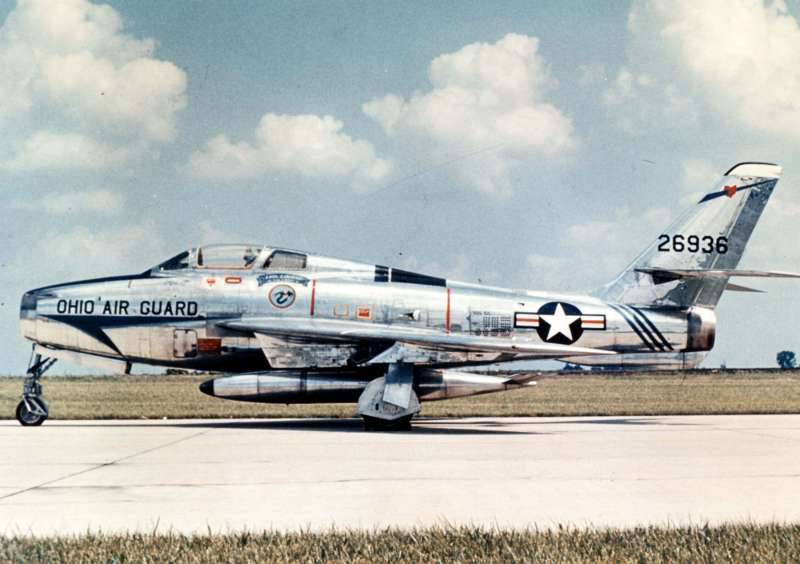
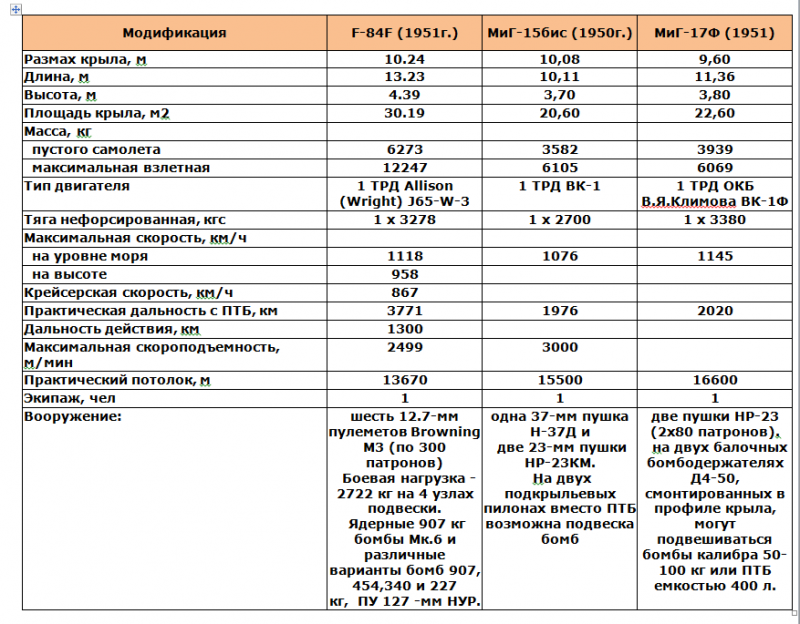
Information